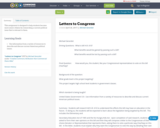
This assignment is designed to help students become more aware citizens by researching a current political issue that is relevant to them.
- Subject:
- Social Science
- Material Type:
- Activity/Lab
- Date Added:
- 04/26/2017

This assignment is designed to help students become more aware citizens by researching a current political issue that is relevant to them.
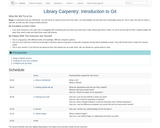
Library Carpentry lesson: An introduction to Git. What We Will Try to Do Begin to understand and use Git/GitHub. You will not be an expert by the end of the class. You will probably not even feel very comfortable using Git. This is okay. We want to make a start but, as with any skill, using Git takes practice. Be Excellent to Each Other If you spot someone in the class who is struggling with something and you think you know how to help, please give them a hand. Try not to do the task for them: instead explain the steps they need to take and what these steps will achieve. Be Patient With The Instructor and Yourself This is a big group, with different levels of knowledge, different computer systems. This isn’t your instructor’s full-time job (though if someone wants to pay them to play with computers all day they’d probably accept). They will do their best to make this session useful. This is your session. If you feel we are going too fast, then please put up a pink sticky. We can decide as a group what to cover.

This Library Carpentry lesson introduces librarians and others to working with data. This Library Carpentry lesson introduces people with library- and information-related roles to working with data using regular expressions. The lesson provides background on the regular expression language and how it can be used to match and extract text and to clean data.
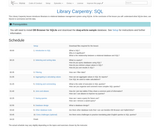
Library Carpentry, an introduction to SQL for Librarians This Library Carpentry lesson introduces librarians to relational database management system using SQLite. At the conclusion of the lesson you will: understand what SQLite does; use SQLite to summarise and link data.
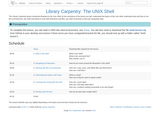
Library Carpentry lesson to learn how to use the Shell. This Library Carpentry lesson introduces librarians to the Unix Shell. At the conclusion of the lesson you will: understand the basics of the Unix shell; understand why and how to use the command line; use shell commands to work with directories and files; use shell commands to find and manipulate data.
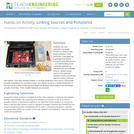
Students use next-generation air quality monitors to measure gas-phase pollutants in the classroom. They apply the knowledge they gained during the associated lesson—an understanding of the connection between air pollutants and their possible sources. Student teams choose three potential pollutant sources and predict how the monitor’s sensors will respond. Then they evaluate whether or not their predictions were correct, and provide possible explanations for any inaccuracies. This activity serves as a simple introduction to the low-cost air quality monitoring technology that students use throughout the associated activities that follow. Three student handouts are provided.

This open access book addresses four standard business school subjects: microeconomics, macroeconomics, finance and information systems as they relate to trading, liquidity, and market structure. It provides a detailed examination of the impact of trading costs and other impediments of trading that the authors call “frictions”. It also presents an interactive simulation model of equity market trading, TraderEx, that enables students to implement trading decisions in different market scenarios and structures. Addressing these topics shines a bright light on how a real-world financial market operates, and the simulation provides students with an experiential learning opportunity that is informative and fun.
Each of the chapters is designed so that it can be used as a stand-alone module in an existing economics, finance, or information science course. Instructor resources such as discussion questions, Powerpoint slides and TraderEx exercises are available online.
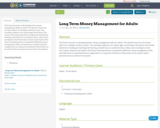
This lesson focuses on developing basic money management skills for adults. The specific time focus for these skills is on multiple months to years. The intended audience is for adults ages 18 and above.The lesson will include elements of reading and writing and listening, and will focus on authentic texts, videos, facts and figures cited from expert research and reports.This lesson will help learners comprehend different money management skills, and help them to understand how to apply them in a long term timeframe.These skills can be used in both a personal sense as well as for business.
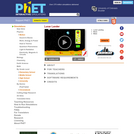
Can you avoid the boulder field and land safely, just before your fuel runs out, as Neil Armstrong did in 1969? Our version of this classic video game accurately simulates the real motion of the lunar lander with the correct mass, thrust, fuel consumption rate, and lunar gravity. The real lunar lander is very hard to control.
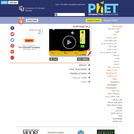
Can you avoid the boulder field and land safely, just before your fuel runs out, as Neil Armstrong did in 1969? Our version of this classic video game accurately simulates the real motion of the lunar lander with the correct mass, thrust, fuel consumption rate, and lunar gravity. The real lunar lander is very hard to control.

Lycaon pictus: Information

Hilfestellungen zur Bedienung der MS Office-Programme sind meist nicht barrierefrei. Und die meisten Inhalte zur Barrierefreiheit richten sich an offensichtlich nicht eingeschränkte Anwender, die für Betroffene arbeiten.
Frei verfügbarere, barrierefreie Inhalte für Betroffene sind bisher nur in fragmentierter oder nicht mehr aktueller Form verfügbar gewesen.
Es fehlte bisher ein barrierefreier, aktueller und ausführlicher Leitfaden für das Programm.
Dieses Werk richtet sich an Menschen, die die Maus nicht bedienen können (in erster Linie blinde und sehbehinderte Menschen), und gibt ihnen einen soliden Einstieg in MS Excel und die wichtigsten Features des Programms.
Der Leitfaden folgt teilweise dem praktischen Beispiel einer einfach gehaltenen Korpusanalyse.
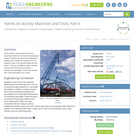
In this activity, students gain first-hand experience with the mechanical advantage of pulleys. Students are given the challenge of helping save a whale by moving it from an aquarium back to its natural habitat into the ocean. They set up different pulley systems, compare the theoretical and actual mechanical advantage of each and discuss their recommendations as a class.
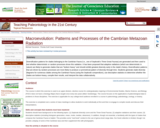
Purpose & Overview:
Many evolutionary biologists and paleontologists have debated whether patterns of diversification through geologic time, like those seen in the Sepkoski Phanerozoic diversity curve, are deterministic or a result of stochastic (i.e., random) processes. Said another way, have patterns in evolutionary diversification been caused by intrinsic or extrinsic factors (e.g., newly evolved morphologic innovations or new ecologic opportunities leading to adaptive radiations) or can they be explained simply by random processes? One way to test these two alternative hypotheses is to generate diversity patterns mathematically in random computer simulations and then compare these stochastically generated patterns to real data-based patterns from the fossil record. If the two are sufficiently different (i.e., their means are shown to be unequal statistically), then the random, null hypothesis can be rejected and the alternative, deterministic hypothesis corroborated. This approach, whereby real patterns are compared to randomly simulated ones, is known as "probabilistic paleontology". Accepting a random, null hypothesis has serious implications for the history of life. If the patterns seen through time could be due to random processes exclusively, then our ideas about natural selection and species selection need to be seriously reconsidered. Perhaps these processes do exist, but they would be of little consequence when it came to long term trends in earth's biota. Some paleontologists have suggested that not only are deterministic factors important, but during types of innovation and ecological opportunity radiating clades should be bottom heavy -- much more species-rich early in their history. Through subsequent history selection eliminates those species less able to compete while those better-adapted species persist. In such situations the tree of life more resembles a pruned bush with many low branches and few persisting higher up (Gould et al. 1987; Gould 1990).
This exercise applies a probabilistic approach to testing causal hypotheses for the pattern of within-clade diversity through the Paleozoic. Metazoans (animals) radiated rapidly in the Cambrian and quickly populated the marine world. Paleontologists have long debated the cause of this radiation. Each person in the class looks at the diversification of 1 or more families of fossils within the Cambrian Fauna. Each student graphically represents within-family diversity data by compiling the ranges of genera through stages of the Paleozoic. Data for ranges of fossil genera are obtained from Sepkoski's compendium (2002) which is accessible through a couple of web sites (see reference list below). The class assumes a priori that randomly generated clade diversity diagrams, when the rates of speciation and extinction are equal, are symmetrical about the mean (Gould et al. 1987).
Materials:
1. Laptop computers running Excel. One per student or fewer if students work in small groups.
2. Access to the Sepkoski database (see URLs below).
3. Sample fossils or images of members of the clade for which each student is compiling range data.
4. Geological time scale showing absolute ages by geologic stage.
Procedure:
1. Each student or small student group is assigned one of the Cambrian Fauna clades from the list of 24.
2. Using the online Sepkoski database, the genera belonging to that clade and their stratigraphic ranges are obtained. The stage of earliest occurrence of a genus in that clade defines the clade's time of origin; the last occurrence of genus defines the clade's extinction. The time between the clade's origination through its extinction defines the temporal units on the histogram's x-axis.
3. In table form, the number of genera extant in each stage is recorded. This defines the number of occurrences along the histogram's y-axis.
4. The temporal mid-point of each stage defines the bin's central value. The file "Sample Clade Statistics" demonstrates how the descriptive statistics are obtained from these ages.
The following files are uploaded as supportive teaching materials:
1. PowerPoint file introducing the exercise and providing the necessary background. Titled: Bottom Heavy Clade Presentation.
2. Handout given to students describing the exercise. Word file titled: Exercise 4 Clade Diversity Exercise.
3. Summary statistics for a collection of Cambrian Fauna clades generated by students. This is intended as sample results and shouldn't be shared with students. Excel file titled: Cambrian Clade Statistics.
4. Handout with a list of 24 Cambrian clades to be included in the analysis using the Sepkoski genus-level compendium. Word file titled: Cambrian Fauna Clades.
5. Excel file showing how descriptive statistics are calculated from the range data. Title: Sample Clade Statistics.
6. File containing genus-level range data for each of the clades included in the above handout. This could be provided to students at the onset or students could acquire these data on their own. Excel file titled: Cambrian Clades in Sepkoski Genus-level Compendium.
(Note: this resource was added to OER Commons as part of a batch upload of over 2,200 records. If you notice an issue with the quality of the metadata, please let us know by using the 'report' button and we will flag it for consideration.)
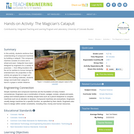
In this activity, students reinforce their understanding of compound machines by building a catapult. This compound machine consists of a lever and a wheel-and-axel. Catapults have been designed by engineers for a variety of purposes from lifting boulders into the air for warfare to human beings for entertainment; the projectiles in this activity are grapes for a magic act. Given the building materials, students design and build their catapult to launch a grape a certain distance.

This course is about maneuvering motions of surface and underwater vehicles. Topics covered include: derivation of equations of motion, hydrodynamic coefficients, memory effects, linear and nonlinear forms of the equations of motion, control surfaces modeling and design, engine, propulsor, and transmission systems modeling and simulation during maneuvering. The course also deals with stability of motion, principles of multivariable automatic control, optimal control, Kalman filtering, and loop transfer recovery. We will also explore applications chosen from autopilots for surface vehicles; towing in open seas; and remotely operated vehicles.
This course was originally offered in Course 13 (Department of Ocean Engineering) as 13.49. In 2005, ocean engineering subjects became part of Course 2 (Department of Mechanical Engineering), and this course was renumbered 2.154.
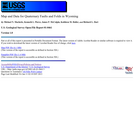
The primary objective of this U.S. Geological Survey Open-file Report is to improve seismic-hazard assessments in regions of Wyoming with low to moderate levels of historic seismicity. A map and pamphlet are available for download in PDF format. The map shows faults and folds with evidence of Quaternary movement including data on timing of the most recent movement, sense of movement, slip rate, and continuity of surface expression.

This course covers basic topics in autonomous marine vehicles, focusing mainly on software and algorithms for autonomous decision making (autonomy) by underwater vehicles operating in the ocean environments, autonomously adapting to the environment for improved sensing performance. It will introduce students to underwater acoustic communication environment, as well as the various options for undersea navigation, both crucial to the operation of collaborative undersea networks for environmental sensing. Sensors for acoustic, biological and chemical sensing by underwater vehicles and their integration with the autonomy system for environmentally adaptive undersea mapping and observation will be covered. The subject will have a significant lab component, involving the use of the MOOS-IvP autonomy software infrastructure for developing integrated sensing, modeling and control solutions for a variety of ocean observation problems, using simulation environments and a field testbed with small autonomous surface craft and underwater vehicles operated on the Charles River.

This course discusses the selection and evaluation of commercial and naval ship power and propulsion systems. It will cover the analysis of propulsors, prime mover thermodynamic cycles, propeller-engine matching, propeller selection, waterjet analysis, and reviews alternative propulsors. The course also investigates thermodynamic analyses of Rankine, Brayton, Diesel, and Combined cycles, reduction gears and integrated electric drive. Battery operated vehicles and fuel cells are also discussed. The term project requires analysis of alternatives in propulsion plant design for given physical, performance, and economic constraints. Graduate students complete different assignments and exams.
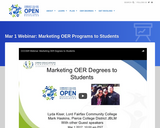
OER programs provide an opportunity for students to earn a certificate or associates degree without incurring the cost of textbooks for their courses. This can dramatically reduce the cost of attendance and has been estimated at 25% or more savings*. Most OER programs are developed to serve the neediest students who may otherwise have to defer college or take fewer courses due to prohibitive cost. Reaching the students who could most benefit most from enrolling in OER courses can prove to be a challenge in of itself. We will hear from speakers who have developed successful strategies at their colleges to create awareness and encourage underrepresented students to enroll in OER degree programs targeted at their academic success.